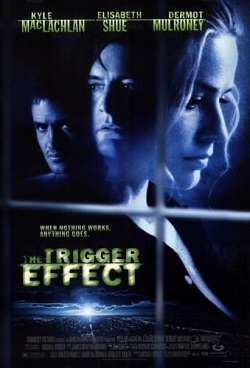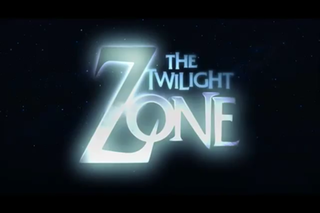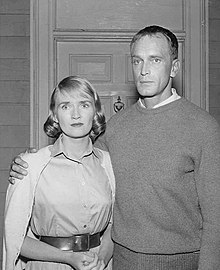
The Twilight Zone is an American media franchise based on the anthology television series created by Rod Serling in which characters find themselves dealing with often disturbing or unusual events, an experience described as entering "the Twilight Zone". The episodes are in various genres, including fantasy, science fiction, absurdism, dystopian fiction, suspense, horror, supernatural drama, black comedy, and psychological thriller, frequently concluding with a macabre or unexpected twist, and usually with a moral. A popular and critical success, it introduced many Americans to common science fiction and fantasy tropes. The first series, shot entirely in black-and-white, ran on CBS for five seasons from 1959 to 1964.

"Where Is Everybody?" is the first episode of the American anthology television series The Twilight Zone and was originally broadcast on 2 October 1959, on CBS. It is one of the most realistic Twilight Zone episodes, as it features no supernatural elements and is based on fairly straightforward extrapolation of science.

"Third from the Sun" is the fourteenth episode of the American television anthology series The Twilight Zone. It is based on a short story of the same name by Richard Matheson which first appeared in the first issue of the magazine Galaxy Science Fiction in October 1950.
"It's a Good Life" is the eighth episode of the third season of the American television series The Twilight Zone, and the 73rd overall. It was written by series creator/showrunner Rod Serling, based on the 1953 short story "It's a Good Life" by Jerome Bixby. The episode was directed by James Sheldon, and is considered by some, such as Time and TV Guide, to be one of the best episodes of the series. It originally aired on November 3, 1961. The episode was one of four from the original 1959 series which formed the basis of the 1983 film Twilight Zone: The Movie.
"The Midnight Sun" is episode 75 of the American television anthology series The Twilight Zone, first shown in November, 1961.

"To Serve Man" is the 24th episode of the third season of the anthology series The Twilight Zone, and the 89th overall. It originally aired on March 2, 1962, on CBS. Based on Damon Knight's 1950 short story of the same title, the episode was written by Rod Serling and directed by Richard L. Bare. It is considered one of the best episodes from the series, particularly for its final twist.

Twilight Zone: The Movie is a 1983 American science fiction anthology film produced by Steven Spielberg and John Landis. Based on Rod Serling's 1959–1964 television series of the same name, the film features four stories directed by Landis, Spielberg, Joe Dante, and George Miller. Landis' segment is an original story created for the film, while the segments by Spielberg, Dante, and Miller are remakes of episodes from the original series. The film's cast includes Dan Aykroyd, Albert Brooks, Scatman Crothers, John Lithgow, Vic Morrow, and Kathleen Quinlan. Original series cast members Burgess Meredith, Patricia Barry, Peter Brocco, Murray Matheson, Kevin McCarthy, Bill Mumy, and William Schallert also appear in the film, with Meredith assuming Serling's role as narrator.
"Treehouse of Horror II" is the seventh episode of the third season of the American animated television series The Simpsons. It first aired on the Fox network in the United States on October 31, 1991. It is the second annual Treehouse of Horror episode, consisting of three self-contained segments, told as dreams of Lisa, Bart and Homer and is the only Treehouse of Horror episode to date where each segment name is not stated inside the episode. In the first segment, which was inspired by W. W. Jacobs's short story The Monkey's Paw and The Twilight Zone episode "A Small Talent for War", Homer buys a Monkey's Paw that has the power to grant wishes, although all the wishes backfire. In the second part, which parodies the Twilight Zone episode "It's a Good Life", Bart is omnipotent, and turns Homer into a jack-in-the-box, resulting in the two spending more time together. In the final segment, Mr. Burns attempts to use Homer's brain to power a giant robotic laborer.
Skysurfer Strike Force is a science-fiction superhero animated series that was featured on Bohbot Entertainment's Amazin' Adventures cartoon block and was co-produced by Ruby-Spears Productions and Ashi Productions. The show lasted two seasons in the mid-1990s. The first episode aired on September 10, 1995, and the last episode was on October 26, 1996. The show then aired in reruns on the Sci Fi Channel in 1999 through 2000. It was the final creation of Ruby-Spears Productions before shutting down.

Pet Alien is an animated television series created by Jeff Muncy of Pajanimals fame, with episodes written by Dan Danko and directed by Andrew Young. The series is a co-production between Mike Young Productions, Antefilms Production, Crest Communications Limited and Telegael Teoranta, in association with John Doze Studios, with the participation of TF1 in co-production with Télétoon and TPS Jeunesse. For Season 2, KI.KA and Europool in Germany joined as co-production partners.
"A Quality of Mercy" is episode 80 of the American television anthology series The Twilight Zone, which originally aired on December 29, 1961. The title is taken from a notable speech in William Shakespeare's The Merchant of Venice, quoted in Serling's closing narration at the end of the episode.
"The Inheritors" is the only two-part episode of the original The Outer Limits television show. It comprises the forty-first and forty-second episodes of the show, in the second season. Part I was first aired on November 21, 1964; Part II on November 28, 1964.
"You Drive" is episode 134 of the American television anthology series The Twilight Zone. It originally aired on January 3, 1964, on CBS. In this episode, the perpetrator of a fatal hit-and-run is hounded by the car he committed the crime with. Earl Hamner Jr. reprised this story, as he had already used it in the 1954 TV series 'Justice'.
"The Fear" is the penultimate episode of the American television series The Twilight Zone. It is the last episode written by series creator/host Rod Serling.

The Nightmare Room is an American children's anthology horror series that aired on Kids' WB. The series was based on the short-lived children's book series that went by the same title created by Goosebumps author, R. L. Stine. The Nightmare Room originally aired from August 31, 2001, to March 16, 2002, in the United States.

The Trigger Effect is a 1996 American thriller film written and directed by David Koepp and starring Kyle MacLachlan, Elisabeth Shue and Dermot Mulroney. The film follows the downward spiral of society during a widespread and lengthy power outage in Southern California. As Koepp's directorial debut, the film was inspired by the 1978 documentary television series Connections, and the 1960 The Twilight Zone episode "The Monsters Are Due on Maple Street", which starred Koepp's uncle, actor Claude Akins.

"Death Ship" is an episode of the American television anthology series The Twilight Zone, based on a 1953 short story with the same title by Richard Matheson. The story was inspired by the legend of the Flying Dutchman. In this episode, a spaceship crew discovers a wrecked replica of their ship with their own dead bodies inside.

The Mist is a 2007 American science-fiction horror film based on the 1980 novella The Mist by Stephen King. The film was written, directed and co-produced by Frank Darabont. Darabont had been interested in adapting The Mist for the big screen since the 1980s. The film features an ensemble cast, including Thomas Jane, Marcia Gay Harden, Nathan Gamble, Andre Braugher, Sam Witwer, Toby Jones, Frances Sternhagen, Buck Taylor, Robert Treveiler, William Sadler, Alexa Davalos, David Jensen, Chris Owen, Andy Stahl and future The Walking Dead stars Jeffrey DeMunn, Laurie Holden, Melissa McBride and Juan Gabriel Pareja.

The Twilight Zone is a science fiction horror anthology television series, presented by Forest Whitaker. It is the second of three revivals of Rod Serling's original 1959–64 television series. It aired for one season on the UPN network, with actor Forest Whitaker assuming Serling's role as narrator and on-screen host. It was a co-production between Spirit Dance Entertainment, Trilogy Entertainment Group, Joshmax Productions Services, and New Line Television. It premiered on September 18, 2002, and aired its final episode on May 21, 2003.

The Outer Limits is an American television series that was broadcast on ABC from September 16, 1963, to January 16, 1965, at 7:30 PM Eastern Time on Mondays. It is often compared to The Twilight Zone, but with a greater emphasis on science fiction stories. It is an anthology of self-contained episodes, sometimes with plot twists at their ends.












